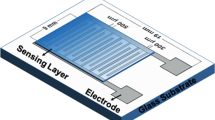Abstract
In this paper, chemiresistor sensor based on conductive polymer (regio-regular poly(3- hexyltiophene) (rr-P3HT) and zinc oxide (ZnO) nanomaterial blend has been investigated and tested including the significant measurements of response characteristic, humidity, and temperature under exposure of nitrogen oxides. For this purpose, an automated experimental setup has been provided in order to interface the gas chamber containing chemiresistors gas sensors and temperature sensor mounted on base chip with the system of pipes and valves, nitrogen and synthetic air gas cylinders, and Mass Flow controller. As well 3D FE model chemiresistor sensor device based on ZnO and graft comb copolymer contained within of a gas chamber has been developed. The rapid change of resistances values for chemiresistor sensor based on ZnO and graft comb copolymer has been observed at the time of exposure to the gas in accordance with the experimental data obtained by chemiresistor devices sensor manufactured in the laboratories of Silesian University of Technology, Gliwice, Poland.











Similar content being viewed by others
Availability of data and materials
Not applicable
Code availability
Not applicable
References
Z. Wang, L. Huang, X. Zhu, X. Zhou, L. Chi, An ultrasensitive organic semiconductor no2 sensor based on crystalline tips-pentacene films. Adv. Mater. 29(38), 1703192 (2017)
X. Yan, Z. Han, Y. Yang, B. Tay, No2 gas sensing with polyaniline nanofibers synthesized by a facile aqueous/organic interfacial polymerization. Sens. Actuators B 123(1), 107–113 (2007)
F.Y. Niyat, M.S. Abadi, Comsol-based modeling and simulation of sno 2/rgo gas sensor for detection of no 2. Sci. Rep. 8(1), 1–12 (2018)
E. Akbari, Z. Buntat, M.T. Ahmadi, H. Karimi, M. Khaledian, Gas sensor modelling and simulation. In: Handbook of Research on Nanoelectronic Sensor Modeling and Applications, pp. 70–116. IGI Global (2017)
V.S. Bhati, M. Hojamberdiev, M. Kumar, Enhanced sensing performance of zno nanostructures-based gas sensors: a review. Energy Rep. 6, 46–62 (2020)
M.R. Alenezi, S.J. Henley, N.G. Emerson, S.R.P. Silva, From 1d and 2d zno nanostructures to 3d hierarchical structures with enhanced gas sensing properties. Nanoscale 6(1), 235–247 (2014)
S. Astie, A. Gue, E. Scheid, L. Lescouzeres, A. Cassagnes, Optimization of an integrated sno2 gas sensor using a fem simulator. Sens. Actuators A 69(3), 205–211 (1998)
P.D. Kałużyński, M. Procek, A. Stolarczyk, Impact of uv radiation on sensing properties of conductive polymer and zno blend for no2 gas sensing at room temperature. Photon. Lett. Poland 11(3), 69–71 (2019)
M. Procek, A. Stolarczyk, T. Pustelny, Impact of temperature and uv irradiation on dynamics of no2 sensors based on zno nanostructures. Nanomaterials 7(10), 312 (2017)
A. Kumar, M. Kumar, R. Kumar, R. Singh, B. Prasad, D. Kumar, Numerical modelling of chemisorption of oxygen gas molecules on the surface of semiconductor for gas sensors applications. Mater. Today 18, 1272–1279 (2019)
M. Procek, T. Pustelny, A. Stolarczyk, Influence of external gaseous environments on the electrical properties of zno nanostructures obtained by a hydrothermal method. Nanomaterials 6(12), 227 (2016)
G. Lo Sciuto, G. Capizzi, S. Coco, R. Shikler, Geometric shape optimization of organic solar cells for efficiency enhancement by neural networks. Lecture Notes in Mechanical Engineering, 789–796 (2017). https://doi.org/10.1007/978-3-319-45781-9_79
G. Lo Sciuto, S. Coco, A 3d finite element model of degradation phenomena in organic solar devices affected by oxidation. Int. J. Energy Environ. Eng. 11(4), 431–437 (2020)
Acknowledgements
We would like to express our gratitude to Dr. Agnieszka Stolarczyk of Department of Physical Chemistry and Technology of Polymers, Silesian University of Technology, Gliwice, Poland, for her support during the scientific and innovative research carried out in laboratory
Funding
The work was partially sponsored by the Faculty of Electrical Engineering of Silesian University of Technology within the Grants BKM/757/RE4/2021 and BKM/758/RE4/2020. The synthesis of graft copolymers was supported by the Foundation for Polish Science grant PARENT BRIDGE no 2011-3/8.
Author information
Authors and Affiliations
Contributions
GLS: conceptualization and developing methodology in laboratory and in modeling; writing—original draft preparation; visualization; data analysis; investigations and review. PK: data inputs for experimental methodology, providing lab facilities. SC: supervision and review
Corresponding author
Ethics declarations
Conflict of interest
The authors declare no competing interests.
Ethical approval
The work contains no libelous or unlawful statements, does not infringe on the rights of others, or contains material or instructions that might cause harm or injury.
Consent to participate
The authors consent to participate.
Consent for publication
The authors consent to publish.
Rights and permissions
About this article
Cite this article
Lo Sciuto, G., Kałużyński, P. & Coco, S. 3D finite element simulation model of a chemiresistor gas sensor based on ZnO and graft comb copolymer integrated in a gas chamber. J Mater Sci: Mater Electron 33, 5037–5048 (2022). https://doi.org/10.1007/s10854-022-07692-1
Received:
Accepted:
Published:
Issue Date:
DOI: https://doi.org/10.1007/s10854-022-07692-1




